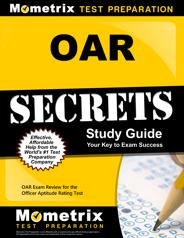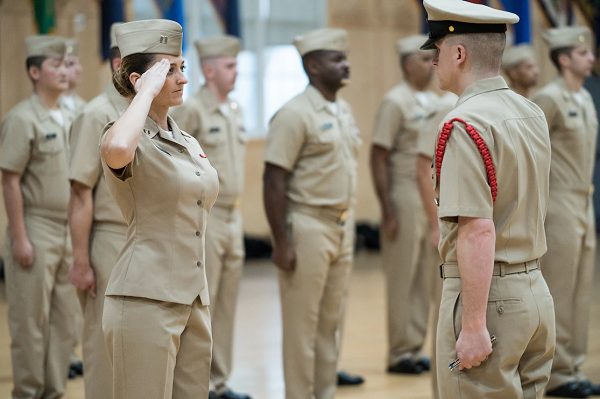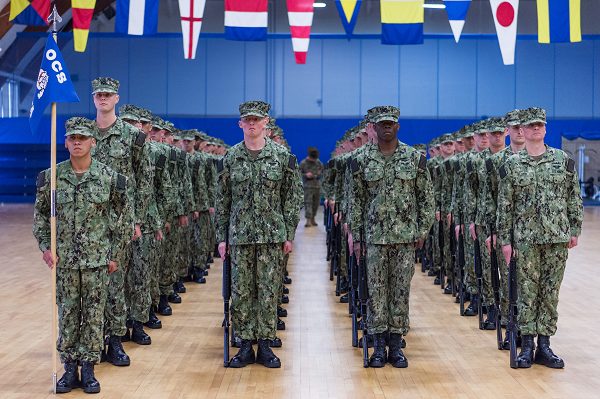If you serve in the Coast Guard, Navy, or Marines, you have likely heard of the OAR test.
Service members who meet the minimum criteria for officer training must take the OAR as a part of the process.
Also, anyone who qualifies to apply for an Officer Training Program can register for the OAR.
However, it is vital to fully understand what the test measures and how to prepare best to ensure you are a competitive candidate.
Need Help Acing The OAR Test?
 Looking to improve your OAR test score? Check out the Mometrix ‘OAR Secrets Study Guide‘.
Looking to improve your OAR test score? Check out the Mometrix ‘OAR Secrets Study Guide‘.
It’s an incredibly detailed 145-page OAR study guide that includes helpful tips on acing the test, practice test questions, and video study tutorials.
And the best part….it’s less than $20!
Click Here to learn more.
Table of Contents
What is the OAR Test?

The Officer Aptitude Rating test (OAR) is a part of a more extensive test called the Aviation Standard Test Battery (ASTB).
If you wish to qualify for officer training, you must perform well on the OAR for consideration.
The OAR determines if you possess the basic skills necessary for success as an officer.
OAR Test Scores Explained
There are three different subtests for the OAR, and each subtest contributes to your overall score.
Each test uses a point system, and the scores range from 20 to 80.
The Navy has a minimum score requirement of 35 for the OAR.
However, keep in mind Officer Training Program entries are competitive, and the minimum will not set you apart from those who are your competition.
The subtests include:
Math Skills
The math section covers basic computations and solving for variables. Also, fractions, exponents, and angles are all on the exam and other topics.
Reading Comprehension
The reading portion of the OAR requires test-takers to read a text and extract meaningful information.
Also, some questions require the ability to infer meaning. In other words, make an educated guess based on what you read.
Mechanical Comprehension
The mechanical subtest covers a wide range of mechanical knowledge such as engines, gasses and liquids, and volume.
Furthermore, expect to cover basic principles of physical science in this subtest.
How to Prepare for the OAR Test
Since candidacy is competitive for Officer Training programs, it is crucial to do well the first time.
Timing is Everything
Your first goal is to prepare with enough time to comfortable study without stress.
Ideally, you know well in advance that you must take the OAR.
Therefore, you can establish a study plan that allows you to prepare without creating even more test anxiety.
Also, to fully understand how much time you need to dedicate to studying, you must first know how much work you need to be ready and evaluate how much time you have each week to commit to the task.
Narrow your Focus with a Practice Test
Before you can truly set up a study plan, you must first know what you need to study.
Ideally, you do not need to relearn or brush up on every skill on the test.
Therefore, if you take a practice test, you can learn in what areas you are weakest and tailor your study plan to focus on those areas first.
However, you must ensure the practice test closely mimics that of the OAR to really give you an idea of how you might do.
Therefore, look for a practice test that focuses on OAR-type questions you can expect to see on the exam.
Once you realize your areas of weakness, you can go back up to your schedule planning and evaluate based on your new information.
In a perfect world, you can spend weeks studying for several hours a week, starting with the topics you struggle with the most.
Set Limits
Another essential preparation tip for the OAR is setting time limits.
The OAR is timed for each of the three subtests.
Therefore, it is vital to set timers for your practice tests and quizzes for two reasons.
First, you learn to process and recall information quickly.
Second, this practice will relieve test anxiety.
By setting limits on yourself, you mimic the conditions of the OAR so you can see how well you perform under pressure.
You might realize you are great with the math subtest as long as you can take your time.
However, when you take the test timed, you may realize you need to increase the speed of your calculations and your knowledge base.
Related Article – Navy ASTB-E Study Guide: 5 Tips To Ace The Test
Frequently Asked Questions

We address some frequently asked questions about the OAR test below.
How long is the test?
The OAR is 90 questions in length, and it is timed.
The Math Skills portion is 40 minutes in length, the Reading Comprehension is 30 minutes, while the Mechanical Comprehension subtest is 15 minutes in length.
Typically, it takes 1.5 hours to 2 hours if you take the test via computer.
However, if you are taking the exam on paper, it may take longer.
Is the OAR Test hard?
The OAR test is challenging.
As mentioned, the exam has three different subtests with multiple choice questions for each section.
Furthermore, there are 30 math questions, 20 reading comprehension questions, and 30 mechanical comprehension questions.
OAR Test Locations
When you are ready to take your OAR exam, reach out to your supervisor or a recruiter.
There are well over 250 testing locations throughout the world.
Once you register for your OAR test, you will receive information on where to take the test and what time.
Can you use a calculator on the OAR test?
You may not take a calculator with you when taking the OAR test.
Also, test takers may not have smartphones, smartwatches, or any other device that could help.
However, you may have scratch paper to work out math problems on paper and pencil.
Be prepared to turn in your scratch paper at the end of your test because it is considered secure testing materials.
How many times can you take the OAR test?
You may retake the OAR test.
However, there is a three times maximum throughout your life.
Therefore, being prepared before the first test is ideal.
Related Article – Can You Retake The ASVAB?
Conclusion
If you wish for selection for an officer training program in the Navy, you need to take the OAR test as part of your application process.
The OAR covers math, reading comprehension, and mechanical comprehension.
The scores from these three subtests contribute to your overall OAR score.
Also, there are minimum requirements for the OAR, but because of competitiveness, it is vital to do well.
You can retake the OAR up to three times, but with careful preparation, you better your odds of success the first time you take the test.
Plan to give yourself plenty of time to study.
Then, take a practice test that mimics the actual OAR test.
Also, be sure to follow the time limits so you can practice and study with the same conditions in which you will test.
References:
See Also
3 Military Flight Aptitude Tests Explained
ASVAB Scores And The Military Jobs That Qualify
Navy Officer Candidate School (OCS) Guide
- Replacing Dog Tags: 6 Things You Need to Know - June 28, 2024
- Navy OAR Test Study Guide - June 24, 2024
- 10 Best Sniper Movies of all Time - June 20, 2024
Originally posted on April 28, 2021 @ 11:02 am
Affiliate Disclosure: This post may contain affiliate links. If you click and purchase, I may receive a small commission at no extra cost to you. I only recommend products I have personally vetted. Learn more.

